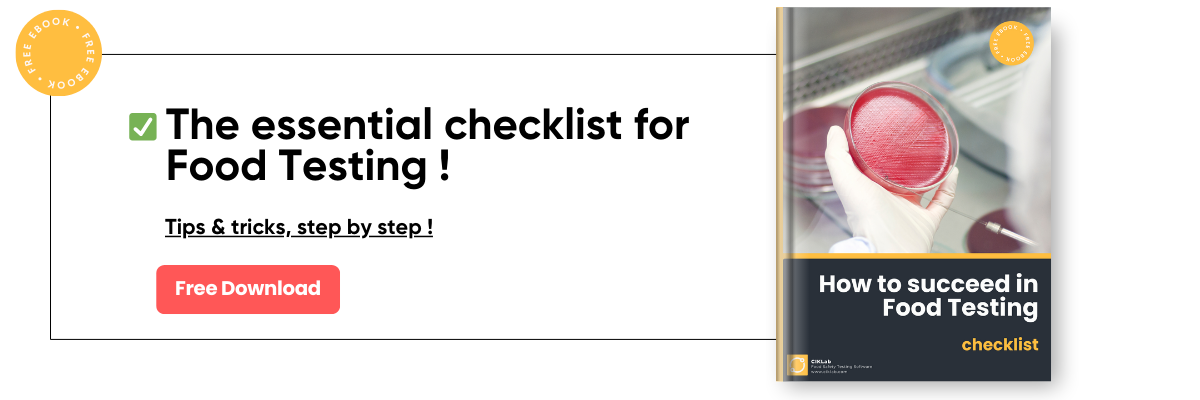
Summary :
2) What are the main natural toxins?
3) Phytotoxins, or plant toxins.
Cyanogenic compounds
4) Mycotoxins
5) How to control natural toxins in food ?
What are natural toxins?
These compounds, although natural, are not necessarily safe for human health. Indeed, nature also produces its own toxins, often as defense mechanisms or as a result of secondary metabolisms following certain forms of stress, for example.
Natural toxins are chemical compounds produced by living organisms that can have harmful effects on human health when ingested, inhaled, or come into contact with the skin.
Unlike other contaminants that are introduced into the food chain by human activities, a significant number of toxins are naturally present in certain foods. This underscores the importance of not automatically associating the term "natural" with "harmless".
In reality, some of the most toxic compounds known are of natural origin ! Examples include botulinum toxin, ricin, and tetrodotoxin.
What are the main natural toxins?
Natural toxins can be classified into different categories based on their origin, chemical structure, or their effects on human health. They can be endogenous to foods like phytotoxins but indirectly contaminate foods like mycotoxins produced by molds or even cyanotoxins produced by blue-green algae (cyanobacteria).
They can be broadly classified into these major groups:
- Phytotoxins produced by plants
- Mycotoxins produced by molds
- Phycotoxins produced by algae
- Cyanotoxins produced by microalgae
- Fungal toxins produced by higher fungi
- Bacteriotoxins produced by bacteria
Phytotoxins, or plant toxins.
Phytotoxins, also known as plant toxins, are toxic substances produced by certain plants. These toxins can be present in various parts of the plant, such as leaves, seeds, roots, stems, or fruits, and often serve as a natural defense mechanism against herbivores, insects, and other predators.
There are many different phytotoxins, each having specific effects on organisms that ingest them. Some phytotoxins are relatively benign to humans and can be destroyed or eliminated by cooking or proper food treatment. However, other phytotoxins are highly toxic and can lead to severe illness or even death when consumed in sufficient quantities. While their presence depends on the part of the plant, the maturity stage is also a factor to consider.
Here is a list of the main and most common plant toxins:
Alkaloids, between poison and medicine
Their name derives from the term "alkaline" and was historically used to characterize any substance containing nitrogen. These compounds (over 8000 listed) are produced by a wide range of living beings, from bacteria to fungi, through plants and animals. Over time, many alkaloids have found their utility in medicine of course, and many have beneficial physiological effects in food (the dose makes the poison!) like caffeine, theobromine, etc.
However, many food products can contain dangerous alkaloids, either endogenously, during contamination in the field, or when livestock consume them.
Here is a list of some families of alkaloids (the list is far too long and complex!)
- Pyrrolizidine alkaloids.
Examples: Retrorsine, Senecionine, Heliotrine, Lycopsamine Some plants of the genera Senecio, Crotalaria, and Heliotropium contain them. They are not typically found in common foods but can contaminate products like honey if bees forage on these plants. They are looked for in herbal dietary supplements, tea, infusions, and dried herbs. - Tropane alkaloids.
Examples: atropine, scopolamine, hyoscyamine.
They are found in certain cereals and infusion plants in particular. - Steroidal alkaloids.
Examples: Solanine, Tomatine, Solasodine Among the sources, we can cite for example Potatoes (for solanine) and Tomatoes (for tomatine). Solanine is present in the green parts of potatoes, so it is recommended not to eat their sprouts or potatoes that have turned green. Solanine is found in many species of the Solanaceae family, such as peppers and eggplants. The levels decrease drastically when the fruits or vegetables are ripe! - Indole alkaloids
Examples: Quinine, Strychnine, Vinblastine, Ergotamine from rye ergot.
Cinchona (for quinine), Strychnos seeds (for strychnine), Madagascar periwinkle (for vinblastine). Quinine is used to make tonics and bitter beverages.. - Pyridine alkaloids
Example: Macaridine from maca
Cucurbitacins
Cucurbitacins are chemical compounds found in the Cucurbitaceae family, which includes vegetables such as zucchinis, cucumbers, and pumpkins. These substances are naturally produced by plants as a defense mechanism against herbivores.
- Cucurbitacin B: found in bitter zucchinis.
- Cucurbitacin E: found in certain types of cucumbers.
Glycoalkaloids
Glycoalkaloids are alkaloids found in the Solanaceae family, which includes tomatoes, peppers, and potatoes. Among the most well-known glycoalkaloids are tomatine, found in green tomatoes, solanine found in eggplants, and in potatoes where it is associated with chaconine.
- Alpha chaconine and Alpha solanine: Potato
- Alpha tomatine and dihydro tomatine: Tomato
- Solanine: Eggplants
Lectins
Lectins are proteins found in certain foods that can cause digestive problems in some individuals. These proteins bind to carbohydrates in our bodies, which can lead to inflammation, gastrointestinal disturbances, or poor nutrient absorption (anti-nutritional factors).
Lectins are present in many plant-based foods, such as legumes (beans, lentils, chickpeas), grains (wheat, rye, oats), fruits and vegetables (tomatoes, potatoes, eggplants), and seeds (almonds, walnuts, sunflower seeds).
Most lectins are destroyed during cooking or high-temperature baking. Therefore, it is recommended to cook foods containing lectins thoroughly to reduce their content and minimize adverse effects.
- Phytohemagglutinin: found in many legumes, such as beans and lentils.
- Concavalin A: Lima beans
- SBA Lectin: soybeans

Cyanogenic compounds
Cyanogenic compounds are chemical substances that can release hydrocyanic acid (HCN) when metabolized. These compounds are present in many plants and can be toxic to humans and animals if ingested in large amounts. Often present in the form of cyanogenic glycosides, they naturally occur in many plants, especially in certain species of cassava, sorghum, bitter almonds, and fruit pits like cherries, apricots, and peaches. These compounds play a defensive role for the plant, protecting them against herbivores.
- Amygdalin: This compound is found in the pits of many stone fruits, such as bitter almonds, cherries, apricots, and peaches.
- Linamarin: Mainly found in cassava and flax.
- Dhurrin: It is found in sorghum, a grain cultivated in many regions of the world.
- Taxiphyllin: Present in certain plants like bamboo.
Oxalic acid
Oxalic acid is an organic compound naturally found in many foods, particularly in several vegetables and plants, such as spinach, rhubarb, beets, nuts, cocoa, tea, and some fruits like berries. Ingesting oxalic acid or oxalate salts in large quantities can be toxic to humans. Oxalates can combine in the body with metal ions like calcium to form calcium oxalate crystals, which can lead to issues such as kidney stones. A massive intake of oxalic acid can result in severe symptoms such as abdominal pain, kidney issues, cardiac disorders, and even death in extreme cases.
- Oxalic acid, oxalates: sorrel, spinach, rhubarb (leaves).
Furocoumarins
Furocoumarins are a group of chemical compounds found in certain plants, notably in citrus fruits, carrots, celery, and parsley. These substances are well-known for their ability to cause photosensitization reactions in some individuals. When the skin is exposed to sunlight after coming into contact with these plants, it can lead to burns, redness, and itching.
The presence of furocoumarins in food is generally safe, as the concentrations are often low. However, some individuals may be more sensitive to these compounds and should, therefore, exercise caution when consuming foods containing furocoumarins.
- Psoralen, xanthotoxin, bergapten, and isopimpinellin: Found in parsnips, celery, carrots, parsley, and dill.
- Bergapten: Found in citrus peels.
Mycotoxins, produced by molds
Mycotoxins, produced by certain species of molds, are often found in cereals, nuts, and dried fruits (Aflatoxins, trichothecenes, fumonisins, ochratoxins). They are also found in fruits (patulin) and even in milk (Aflatoxin M1)
Phycotoxins from Algae
Phycotoxins are toxins produced by certain living aquatic organisms. They are primarily found in algae but can also be found in other marine organisms such as mollusks, crustaceans, and fish. These toxins can be hazardous to human health when ingested through the consumption of contaminated food.
There are different classes of phycotoxins, each with specific effects on the body. For example, tetrodotoxin is a toxin found in pufferfish, which can cause paralysis and rapid death in individuals who consume it. Saxitoxin is another phycotoxin produced by certain algae and is responsible for shellfish paralysis. Ciguatoxin is a phycotoxin found in some reef fish and can lead to symptoms such as nausea, vomiting, and neurological disorders.
- Saxitoxin: a neurotoxin produced by certain algae and responsible for shellfish paralysis.
- Ciguatoxin: found in certain reef fish.
Cyanotoxins produced by cyanobacteria
Cyanotoxins are toxins produced by cyanobacteria, also known as blue-green algae. These toxins can contaminate freshwater bodies such as lakes, rivers, and ponds, as well as water reservoirs used for human consumption. The presence of cyanotoxins in water can be hazardous to human health, as they can cause gastrointestinal problems, skin irritations, and respiratory issues. They are also found in microalgae like spirulina.
There are different classes of cyanotoxins, each with different effects on the body. For example, microcystins are cyanotoxins that can cause liver problems in individuals who ingest them. Anatoxins, on the other hand, are cyanotoxins that can act as neurotoxins, causing symptoms such as tremors, seizures, and even death. Nodularins can also be mentioned.
- Microcystins
- Anatoxins
- Nodularins
How to control natural toxins in food ?
When managing a wide range of food products and raw materials, it is essential to be aware of the diversity of potential hazards present in foods. In addition to human-origin chemical contaminants that can be horizontally deployed (such as heavy metals, pesticides, and melamine, etc.), it is important to be aware that many food items contain specific endogenous hazards such as natural food toxins.
Highly detailed control plans
To ensure food safety, it is vital to centralize and establish specific control plans for each category of food products. This involves relying on current regulations, scientific publications, opinions from the European Food Safety Authority (EFSA), and recommendations from the professional sector to which one belongs.
This approach enables the implementation of vertical surveillance, targeting each category of products such as algae, cereals, vegetables and fruits, plants, aromatic and medicinal plants (PPAM), among others.
Analytical expertise within reach of control.
The diversity of potential toxic molecules in food requires referencing a significant number of control analyses to quantify each specific hazard. However, few laboratories are capable of quantifying and providing expertise on each of these toxins. That is why it is necessary to rely on a network of specialized laboratories to cover all potential hazards.
Summarized:
- Identify all potential hazards (horizontal and vertical).
- Select specific control analyses.
- Choose and reference specialized subcontracting laboratories.
- Easily construct and manage control plans.

💡 These articles might also interest you:
>> Which analyses are absolutely essential in food industry ?
>> Quality Control plans for the food industry, what solutions to be efficient?
>> How to simplify the process of food safety testing ?
©2024 CIKLab.com All rights reserved.







